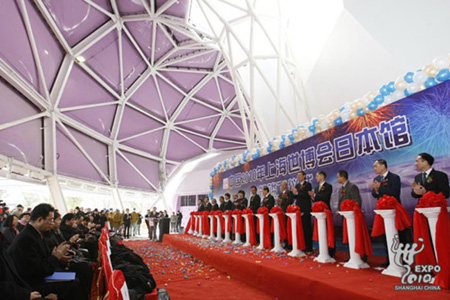Construction finished on December 26 at the Japan Pavilion for the World Expo 2010. It will highlight the country's smart robots and its friendly ties with China.
|
 Scene of the completion celebration ceremony for the Japan Pavilion [en.expo2010]
Scene of the completion celebration ceremony for the Japan Pavilion [en.expo2010] |
The robots for the Expo will be transported to Shanghai around March, said Hiroshi Tsukamoto, commissioner general of the Japanese section of Expo 2010.
A dozen of robots will be exhibited in the pavilion. Some of them can lend a hand to elderly and others will play violins.
A 90-seat restaurant will serve Japanese food with more than 300 yuan (US$43.95) a meal, Chiaki Takahashi, parliamentary secretary of Minister of Economy, Trade and Industry, said at a press conference after a ceremony for the key construction step.
A teahouse surrounded by Sakura trees will showcase the sado, or the tea-making skills of Japan, in the pavilion.
More than 1.75 million Japanese are expected to the Expo site during the 184-day event, accounting for 2.5 percent of the total number of Expo visitors, Takahashi said.
A great number of Japanese will visit the Expo at the beginning of May, which will be the week-long Labor Day holiday of Japan, he added.
The Japan Pavilion, which is always among the most popular pavilions during previous World Expos, is expected to attract 17,000 visitors every day,
The centerpiece performance of the pavilion will be an opera which combines both China's Kunqu opera and Japan's Noh drama to show friendship and exchanges between the two countries, Tsukamoto said.
The opera will tell the story of a rare bird that has avoided extinction in Japan with the help of China.
The crested ibis was declared extinct in Japan in the 1970s. The Chinese government began giving some of its stock to Japan in the 1990s and the birds managed to re-establish themselves in Japan.
The 20-minute opera will be performed in the pavilion's 500-seat theater. A total of 35 sessions will be played every day.
The Japan Pavilion has secured a 6,000-square-meter plot at the Expo site, neighboring the South Korea Pavilion and close to the China Pavilion.
With a budget of 13 billion yen (US$143 million), the 24-meter-high pavilion is the largest and most costly the country has ever built for a World Expo.
The pavilion is a semi-circular structure and covered by a purple membrane material. Its facade is similar to China's National Aquatics Center, or Water Cube, in Beijing. Several antennae and caves make the pavilion a "breathing organism," which will express the harmony between the human heart and technology.
Japanese organizer has adopted "Purple Silkworm Island" as its Chinese name, which was the outcome of a solicitation campaign among Chinese people.
The pavilion will use solar energy collection batteries hidden in the double-layer membrane, and the caves will collect rainwater to spray on its exterior surface to keep temperatures cool.
Inside the pavilion, Japan will arrange exhibitions to interpret its theme -- the "harmony between the human heart and technology".

